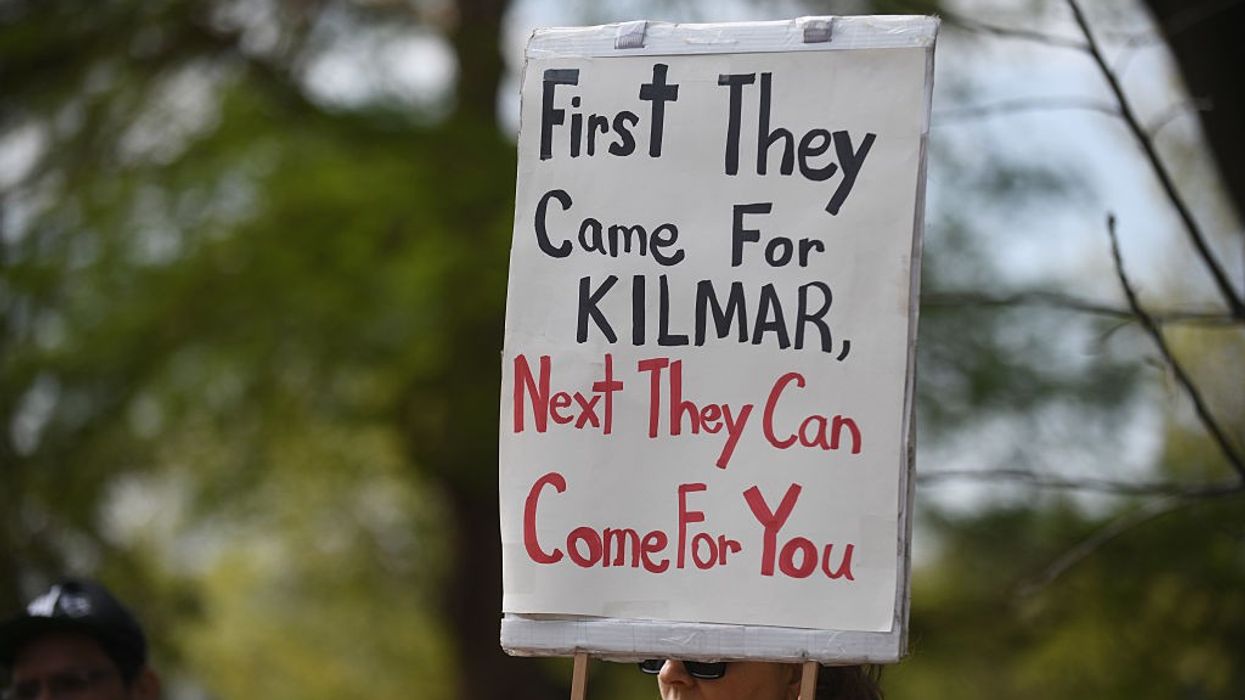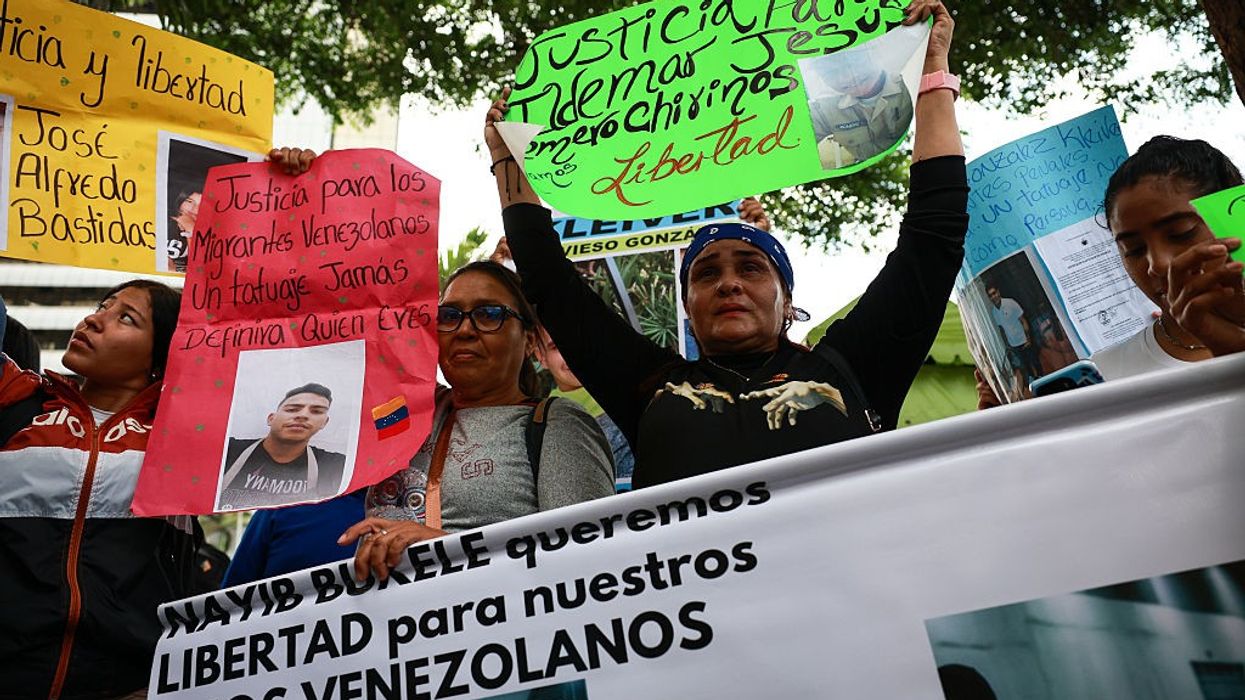Kilmar Abrego García and the Trump Torture Regime
In the age of Donald Trump, we face a government which is willing to directly terrorize people in this country with the threat of torture (even if in a distant land).
I didn’t want to write this article.
In fact, I had something relatively uplifting planned: an Independence Day piece about the rich implications for the present moment to be found in the Declaration of Independence. But other excellent writers beat me to that one.
So instead, I reluctantly find myself once again focusing on U.S. torture, a subject I’ve studied and written about since the autumn of 2001, including in a couple of books. I’d naively hoped never to have to do so again, but here we are.
The Rendition of Kilmar Abrego García
This March, the Trump administration illegally sent Kilmar Abrego García to a notorious hellhole in El Salvador. That mega-prison is known by the acronym CECOT for Centro de Confinamiento del Terrorismo. (In English, the Terrorism Confinement Center.) There he was beaten and tortured in violation of both this country’s immigration and federal laws, as well as the United Nations’ Convention against Torture, or CAT, to which the United States is a signatory.
It didn’t matter that Abrego García was in this country legally and that, as a Justice Department attorney told a federal judge, his deportation was the result of an “administrative error.” In fact, the Department of Justice later rewarded its own lawyer’s honesty by firing him.
Kilmar Abrego García is a citizen of El Salvador who entered the United States “without inspection” (that is, undetected by U.S. Immigration and Customs Enforcement, or ICE) in 2011. He was 16-years-old and fleeing his home country where, “[b]eginning around 2006, gang members stalked, hit, and threatened to kidnap and kill him in order to coerce his parents to succumb to their increasing demands for extortion,” according to a civil suit filed against various U.S. officials. “He then made his way to the state of Maryland, where his older brother, a U.S. citizen, resided.”
There’s another expression to describe what happened to Abrego García, one that will be familiar to anyone who followed the news during the first decade and a half of this century: extraordinary rendition.
Abrego García lived in Maryland for years, working as a day laborer. In 2016, he began a relationship with a U.S. citizen, Jennifer Vásquez Sura, and in 2018, they moved in together. They conceived a child and Abrego García did construction work to support the family, which included his wife’s two children, both U.S. citizens. In March 2019, however, he and three other men were arrested outside a Home Depot by Prince George’s County, Maryland police. They turned him over to ICE, claiming on the flimsiest of evidence that he was a member of the Salvadoran gang, MS-13. The “evidence” in question included the fact that he was wearing a Chicago Bulls hat and hoodie and that a confidential informant had identified him to a detective as a member of an MS-13 group operating out of Long Island, New York, where he had never lived. (The detective was later suspended for unrelated infractions.)
After almost six months in detention, during which time his son was born, an immigration court granted Abrego García a “withholding of removal.” That meant he would be allowed to remain in the United States and could legally work here, because he was believed to face genuine danger were he to be deported to El Salvador. He was required to check in annually with ICE, which he did, most recently in early January 2025.
Things were going relatively well. He had become a union member and was employed full time as a first-year sheet metal apprentice on a trajectory toward a rewarding career in the building trades. On March 12, 2025, however, everything changed. He was driving home from his jobsite after picking up his son (who is deaf in one ear, has intellectual disabilities, and does not speak) when ICE officers pulled his car over and arrested him. Officers gave his wife just 10 minutes to arrive and get their child, threatening to turn him over to Child Protective Services if she missed that deadline.
After being shuttled from state to state, Abrego García ended up at a Louisiana detention center, from which he was indeed deported to El Salvador along with several other men late on the evening of March 15. The people detaining him kept saying he would have a chance to speak to a judge about his legal status, but that was a blatant lie. As his court filing recounts:
He repeatedly requested judicial review. Officials consistently responded with false assurances that he would see a judge, deliberately misleading Plaintiff Abrego Garcia to prevent him from taking actions to assert his legal rights. Plaintiff Abrego Garcia only realized the true nature of his dire situation upon arrival at the airport in El Salvador, at which point it was too late to challenge the unlawful deportation.
Meanwhile, his wife had been desperately trying to find him by checking ICE’s online Detainee Locator System and calling detention centers around the country. Days after he’d already been shipped to El Salvador, the Locator System continued to say that he was at the East Hidalgo Detention Center in La Villa, Texas.
In fact, Kilmar Abrego García had been disappeared. His wife might never have found him if it weren’t for a photo someone sent her from an article about more than 200 Venezuelan immigrants dispatched to CECOT in El Salvador at the same time. His face wasn’t visible, but she recognized him from two scars on his shaved head and some of his personal (but not gang-related) tattoos. She was well aware of CECOT’s reputation as a brutal mega-prison, a site of organized physical and psychological torture.
Once she knew where her husband was, efforts to get him back began. In April, a federal district judge ordered his return, a decision later affirmed by the Supreme Court (which has in these months rarely sided against U.S. President Donald Trump). But the government dragged its feet, refusing to abide by either court’s ruling. Eventually, after maintaining for months that Abrego García was beyond its reach, the Department of Justice reversed itself and brought him back to the United States to face charges of human smuggling in Tennessee, where he remains in federal prison today. Those charges, based on a 2016 Tennessee traffic stop, appear flimsy at best.
Echoes of the “War on Terror”
There’s another expression to describe what happened to Abrego García, one that will be familiar to anyone who followed the news during the first decade and a half of this century: extraordinary rendition. That U.S. government practice of shipping detainees to torture sites around the world was a feature of the “Global War on Terror” (declared by the George W. Bush administration after the 9/11 attacks). As early as 2002, Washington Post reporters Dana Priest and Barton Gellman quoted a U.S. official in Afghanistan, who told them: “We don’t kick the shit out of them. We send them to other countries so they can kick the shit out of them.”
Ordinary rendition involves sending someone to another country after a formal request for extradition. Extraordinary rendition bypasses all the legal niceties and sends a prisoner to another country without any due process whatsoever. It’s important to call things by their proper names. Extraordinary rendition is what happened to Abrego García. During the “war on terror,” and once again today, such an act carries the risk of torture with it. As Human Rights Watch reported in 2011:
Detainees were… unlawfully rendered [transferred] to countries such as Syria, Egypt, and Jordan, where they were likely to be tortured.... Evidence suggests that torture in such cases was not a regrettable consequence of rendition; it may have been the purpose.
Abrego García was unlawfully rendered to El Salvador where, according to his suit, he was subjected to sleep deprivation, beatings, and psychological torture. Specifically,
Upon arrival at CECOT, the detainees were greeted by a prison official who stated, “Welcome to CECOT. Whoever enters here doesn’t leave.” Plaintiff Abrego Garcia was then forced to strip, issued prison clothing, and subjected to physical abuse including being kicked in the legs with boots and struck on his head and arms to make him change clothes faster. His head was shaved with a zero razor, and he was frog-marched to cell 15, being struck with wooden batons along the way. By the following day, Plaintiff Abrego Garcia had visible bruises and lumps all over his body.
In Cell 15, Plaintiff Abrego Garcia and 20 other Salvadorans were forced to kneel from approximately 9:00 pm to 6:00 am, with guards striking anyone who fell from exhaustion. During this time, Plaintiff Abrego Garcia was denied bathroom access and soiled himself. The detainees were confined to metal bunks with no mattresses in an overcrowded cell with no windows, bright lights that remained on 24 hours a day, and minimal access to sanitation.
Note that extraordinary rendition is illegal, both under the United Nations Convention Against Torture, where it is identified by the term “refoulement,” and under the U.S. Foreign Affairs Act of 1998, which states, “It shall be the policy of the United States not to expel, extradite, or otherwise effect the involuntary return of any person to a country in which there are substantial grounds for believing the person would be in danger of being subjected to torture, regardless of whether the person is physically present in the United States.” That last clause relates to a practice known as “chain refoulement,” in which someone is first sent to a third country where the risk of torture is less, only to be sent on to the original prohibited destination. In the unlikely event that, in the future, district federal courts and then the Supreme Court prohibit the Trump administration from shipping detainees off to countries with well-known torture risks, its officials are likely to resort to paying off other, non-torturing nations to serve as trans-shipment sites.
Not the Only Victim
Kilmar Abrego García may turn out to be the most fortunate of the hundreds of migrants shipped from the U.S. to El Salvador in March. An intervention by Maryland Sen. Chris Van Hollen pried him out of CECOT and got him transferred to a different Salvadoran prison. (It’s unclear why the Trump administration finally decided to bring him back to the United States.) Although he remains in federal custody, at least for the moment, he isn’t languishing incommunicado in El Salvador.
The 238 Venezuelan detainees sent to CECOT at the same time haven’t been that lucky. Like Abrego García, they were labeled terrorists and deported without benefit of due process. Trump and his aides called them “rapists,” “savages,” “monsters,” and “the worst of the worst.” But as the investigative journalism organization ProPublica revealed, the administration knew all along that those allegations were false. As the data they reviewed indicates:
The government knew that only six of the immigrants were convicted of violent crimes: four for assault, one for kidnapping, and one for a weapons offense. And it shows that officials were aware that more than half, or 130, of the deportees were not labeled as having any criminal convictions or pending charges; they were labeled as only having violated immigration laws.
Yet it seems likely that, without any judicial proceedings whatsoever, those men have received life sentences in a Salvadoran hellhole for the crime of seeking a better life in the United States.
It Could Happen to You
Most of the discussion in the press and in legal and philosophical circles about the U.S. use of torture during the war on terror assumed the legitimacy of torture’s main pretext: the need to extract lifesaving information from unwilling detainees. At the time, some arguments against it focused on torture’s efficacy: did torturing people truly produce “actionable intelligence”? Others took that effectiveness for granted, while questioning its ethics: Could the torture of a few be justified to save the many? The apotheosis of that false conundrum was the “ticking time bomb” problem.
I say “false conundrum” because such gathering of information is almost always a pretext for a program of institutionalized state torture. Its real political purpose is to maintain the power of the torturing regime by generating fear in anyone who might oppose it. This has been proven repeatedly in studies of torture regimes from Latin America to the Philippines and was no less true, in an oblique way, for the well-documented U.S. torture program of those “war on terror” years.
Anything we do today to maintain human connections—that smile at a grocery cashier, that phone call to an old friend, that little gathering with fellow knitters—is also an act of solidarity in such grim times.
Most torture regimes directly target members of their own societies, hoping to frighten them into compliance through the knowledge that opponents of the regime are being tortured and that they could be next. The Bush-Cheney administration, however, used torture more indirectly to remind Americans that they were in mortal danger from the country’s enemies and that only the administration could protect them from that. The proof of that danger was the very fact that a self-evidently good government nonetheless was forced to commit such terrible acts at CIA “black sites” globally and elsewhere.
Today, in the age of Donald Trump, we face a government which is indeed willing to directly terrorize people in this country with the threat of torture (even if in a distant land). Every torture regime will identify a group or groups of people as “legitimate” targets. In the United States today, immigrants form just such a group, characterized by the Trump administration as either superhuman (“terrorists,” “monsters”) or subhuman (“vermin”). Super- or sub-, they are deemed unworthy of ordinary human rights.
But the fear generated by such threats of torture penetrates beyond those most immediately threatened, encouraging everyone else to comply with and bow down before the regime. Trump has indeed claimed that “the homegrowns are next.”
Building Solidarity
Institutionalized state torture destroys social solidarity by sowing distrust. Writing about Uruguay’s 1973-1985 dictatorship, Lawrence Weschler described how that government assigned every citizen a letter “grade” of A, B, or C. A’s were deemed good citizens and eligible for state employment; B’s were suspect and eligible only for private employment; C’s lost all their rights and posed a danger to anyone who hired or associated with them. “And,” wrote Weschler, “the point was that anyone at any time could suddenly find himself reclassified as a ‘C’—because, after all, they knew everything.” (And how much more do “they” know about us today, now that federal data about each one of us is rapidly being centralized and consolidated?)
One effect of Uruguay’s torture regime was a profound social isolation. As one respondent told Weschler:
Fear exterminated all social life in the public realm. Nobody spoke in the streets for fear of being heard… One tried not to make new friends, for fear of being held responsible for their unknown pasts. One suspected immediately those who were more open or less afraid, of being “agents provocateurs” of the intelligence services. Rumors about torture, arrests, mistreatments were so magnified by our terror as to take on epic proportions.
Those of us living in the United States of 2025 are already being called on to resist the centrifugal forces of isolation and mistreatment in the age of Trump. In this time of torture redux, small efforts to maintain social connections become real acts of resistance. We have already seen whole neighborhoods spontaneously resist ICE raids by pouring into the streets. That is one crucial kind of solidarity. I’d argue that anything we do today to maintain human connections—that smile at a grocery cashier, that phone call to an old friend, that little gathering with fellow knitters—is also an act of solidarity in such grim times. We will need them all in the days to come.


